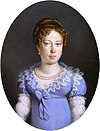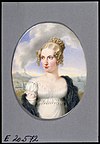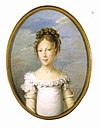| This article needs additional citations for verification. Please help improve this article by adding citations to reliable sources. Unsourced material may be challenged and removed. Find sources: "Maria Theresa of Naples and Sicily" – news · newspapers · books · scholar · JSTOR (October 2023) (Learn how and when to remove this message) |
| Maria Theresa of Naples and Sicily | |||||
|---|---|---|---|---|---|
 Portrait by Élisabeth Vigée Le Brun, 1790 Portrait by Élisabeth Vigée Le Brun, 1790 | |||||
| Holy Roman Empress | |||||
| Tenure | 5 July 1792 – 6 August 1806 | ||||
| Queen consort of Hungary and Bohemia Archduchess consort of Austria | |||||
| Tenure | 1 March 1792 - 13 April 1807 | ||||
| Coronation | 11 August 1793, Prague | ||||
| Empress consort of Austria | |||||
| Tenure | 11 August 1804 – 13 April 1807 | ||||
| Born | (1772-06-06)6 June 1772 Royal Palace, Naples, Kingdom of Naples | ||||
| Died | 13 April 1807(1807-04-13) (aged 34) Hofburg Palace, Vienna, Austrian Empire | ||||
| Burial | Imperial Crypt | ||||
| Spouse |
Francis II, Holy Roman Emperor
(m. 1790) | ||||
| Issue Among others.. | |||||
| |||||
| House | Bourbon-Two Sicilies | ||||
| Father | Ferdinand I of the Two Sicilies | ||||
| Mother | Maria Carolina of Austria | ||||
Maria Theresa of Naples and Sicily (6 June 1772 – 13 April 1807) was the first Empress of Austria and last Holy Roman Empress as the spouse of Francis II. She was born a Princess of Naples as the eldest daughter of King Ferdinand I of the Two Sicilies and Queen Maria Carolina.
Biography

Early life
Born on 6 June 1772 at the Royal Palace of Naples, Maria Theresa Carolina Giuseppina was the eldest child of Ferdinand I of the Two Sicilies and his wife Maria Carolina. She was her mother’s favorite child from birth, and was henceforth named after her maternal grandmother Empress Maria Theresa. Princess Maria Theresa was taught French, mathematics, geography, theology, music, dancing, and drawing.
In the February of 1790, Archduke Francis’s wife, Archduchess Elisabeth, died in childbirth, and it was announced that he would marry one of the princesses of Naples. Maria Theresa and her sister Luisa were both considered for the match. In the end, though, Luisa was chosen to marry Ferdinand III, Grand Duke of Tuscany, and Maria Theresa was to marry Francis. The marriage was in accordance with the traditional House of Habsburg marriage policy.
Marriage
On 15 September 1790, at the age of 18, Princess Maria Theresa married her double first cousin Archduke Francis. Francis would, in 1792, become Holy Roman Emperor. Eventually, in 1804, he would become the first Emperor of Austria. The marriage was described as a happy one based on mutual understanding, despite differences in personality. Francis was described as a melancholic character. He was shy and reserved, and was serious with a preference for a spartan lifestyle and duty. Maria Theresa, on the other hand, was described as a gracious blue-eyed blonde with a vivacious personality, a hot temper and a sensual nature. Despite these differences in personality, they were reported to have a good understanding of each other and had a very good relationship.
Maria Theresa reportedly adapted well to her new home in Vienna and did not suffer from homesickness. She participated with enthusiasm in court life, and it was noted that she enjoyed dancing and partaking in carnival balls—even while pregnant. She particularly enjoyed the Waltz, which had been recently introduced as an innovation and became fashionable during her years in Vienna.
Hedvig Elisabeth Charlotte of Holstein-Gottorp described the view of Maria Theresa and the relationship between the couple in her famous diary during her visit to Vienna in 1798–99:
The Empress is reputed to be so jealous that she does not allow him to take part in social life or meet other women. Vicious tongues accuse her of being so passionate that she exhausts her consort and never leaves him alone even for a moment. Although the people of Vienna cannot deny that she is gifted, charitable and carries herself beautifully, she is disliked for her intolerance and for forcing the Emperor to live isolated from everyone. She is also accused of interesting herself in unimportant matters and socializing exclusively with her lady-companions. With them she spends her evenings singing, acting out comedies and being applauded.
On 12 December 1791, the firstborn child of Princess Maria Theresa and Archduke Francis was born: Marie Louise. She was educated specifically in French, English, Spanish, Italian and Latin, with the expectation of her native language German. Marie Louise would soon marry Emperor Napoleon, due to the ongoing wars with France that were effecting her parents and grandparents.
Holy Roman Empress

In 1792, Maria Theresa’s husband Francis ascended the throne as King of Hungary, Croatia and Bohemia, and she became queen consort. In the same year, she would become Holy Roman Empress. The-then Empress Maria Theresa was interested in politics and came to play a certain role in state affairs due to her influence over her spouse, to whom she acted as an adviser. She was a conservative force and belonged to the critics of Napoleon, and was reported to have encouraged Francis in an anti-French position during the Napoleonic Wars. She has also been pointed out for being partially responsible for the dismissal of Johann Baptist Freiherr von Schloissnigg and Graf Franz Colloredo.
In February of 1799, her seeming indifference to the flight of her parents from Naples attracted some disfavour in Vienna. Although she was her mother’s favorite child, she was biased when it came to their exile during the war.
An important patron of Viennese music, she commissioned many compositions for official and private use. Joseph Haydn wrote his Te Deum for chorus and orchestra at her request. Her favourite composers included Paul Wranitzky and Joseph Leopold Eybler, a composer of sacred music.
Death

In the winter of 1806, Empress Maria Theresa (pregnant with her 12th child) contracted tuberculous pleurisy, which the imperial physician, Andreas Joseph von Stifft, treated with bloodletting. However, it did not trigger an improvement in health. On 6 April 1807 Empress Maria Theresa gave birth prematurely to a daughter who lived only 3 days. One week later, on 13 April, the empress died as well. The emperor was inconsolable and had to be removed by force from the corpse of his wife. She was buried in the Imperial Crypt in Vienna. The shattered emperor stayed away from the funeral, instead traveling to Buda with his two eldest children. The urn containing her heart was placed in the Heart Crypt and the urn with her entrails in the Ducal Crypt. Empress Maria Theresa is one of the 41 people who received a "separate burial" with the body divided between all three traditional Viennese burial sites of the Habsburgs (Imperial Crypt, Heart Crypt, Duke Crypt).
Issue
| Children of Maria Theresa of Naples and Sicily | ||||
|---|---|---|---|---|
| Name | Picture | Birth | Death | Notes |
| By Francis II, Holy Roman Emperor | ||||
| Archduchess Marie Louise |  |
12 December 1791 | 17 December 1847 (aged 56) | Married first Emperor Napoleon I of France, had issue, married second Adam, Count of Neipperg, had issue, married third to Charles, Count of Bombelles, no issue. |
| Emperor Ferdinand I of Austria |  |
19 April 1793 | 29 June 1875 (aged 82) | Married Maria Anna of Savoy, Princess of Sardinia, no issue. |
| Archduchess Maria Caroline | 8 June 1794 | 16 March 1795 (aged 0) | Died in childhood, no issue. | |
| Archduchess Caroline Ludovika | 22 December 1795 | 30 June 1797 (aged 1) | Died in childhood, no issue. | |
| Archduchess Caroline Josepha Leopoldine |  |
22 January 1797 | 11 December 1826 (aged 29) | Renamed Maria Leopoldina upon her marriage; married Pedro I of Brazil, had issue. |
| Archduchess Maria Clementina Franziska Josepha |  |
1 March 1798 | 3 September 1881 (aged 83) | Married her maternal uncle Leopold, Prince of Salerno, had issue. |
| Archduke Joseph Franz Leopold |  |
9 April 1799 | 30 June 1807 (aged 8) | Died some weeks after his mother in childhood, no issue. |
| Archduchess Marie Caroline |  |
8 April 1801 | 22 May 1832 (aged 31) | Married Crown Prince (later King) Frederick Augustus II of Saxony, no issue. |
| Archduke Franz Karl |  |
17 December 1802 | 8 March 1878 (aged 75) | Married Princess Sophie of Bavaria; father of Franz Joseph I of Austria and Maximilian I of Mexico. |
| Archduchess Marie Anna |  |
8 June 1804 | 28 December 1858 (aged 54) | Born intellectually disabled (like her eldest brother, Emperor Ferdinand I) and to have suffered from a severe facial deformity. Died unmarried. |
| Archduke Johann Nepomuk | 30 August 1805 | 19 February 1809 (aged 3) | Died in childhood, no issue. | |
| Archduchess Amalie Theresa | 6 April 1807 | 9 April 1807 (aged 0) | Died in childhood, no issue. | |
Ancestry
| Ancestors of Maria Theresa of Naples and Sicily | |||||||||||||||||||||||||||||||||||||||||||||||||||||||||||||||||||||||||||||||||||||||||||||||||||||||||||||||||||||||||||||||||||||||||||||||||||||||||||||||||||||||||||||||||||||||||||||||||||||||||||||||||||||||||||||||||||||||||||||||||||||||||||||||||||||||||||||||||||||||||
|---|---|---|---|---|---|---|---|---|---|---|---|---|---|---|---|---|---|---|---|---|---|---|---|---|---|---|---|---|---|---|---|---|---|---|---|---|---|---|---|---|---|---|---|---|---|---|---|---|---|---|---|---|---|---|---|---|---|---|---|---|---|---|---|---|---|---|---|---|---|---|---|---|---|---|---|---|---|---|---|---|---|---|---|---|---|---|---|---|---|---|---|---|---|---|---|---|---|---|---|---|---|---|---|---|---|---|---|---|---|---|---|---|---|---|---|---|---|---|---|---|---|---|---|---|---|---|---|---|---|---|---|---|---|---|---|---|---|---|---|---|---|---|---|---|---|---|---|---|---|---|---|---|---|---|---|---|---|---|---|---|---|---|---|---|---|---|---|---|---|---|---|---|---|---|---|---|---|---|---|---|---|---|---|---|---|---|---|---|---|---|---|---|---|---|---|---|---|---|---|---|---|---|---|---|---|---|---|---|---|---|---|---|---|---|---|---|---|---|---|---|---|---|---|---|---|---|---|---|---|---|---|---|---|---|---|---|---|---|---|---|---|---|---|---|---|---|---|---|---|---|---|---|---|---|---|---|---|---|---|---|---|---|---|---|---|---|---|---|---|---|---|---|---|---|---|---|---|---|---|---|---|
| |||||||||||||||||||||||||||||||||||||||||||||||||||||||||||||||||||||||||||||||||||||||||||||||||||||||||||||||||||||||||||||||||||||||||||||||||||||||||||||||||||||||||||||||||||||||||||||||||||||||||||||||||||||||||||||||||||||||||||||||||||||||||||||||||||||||||||||||||||||||||
References
- ^ "Maria Theresa - the last Holy Roman Empress". Italy On This Day. Retrieved 27 June 2022.
- Charlottas, Hedvig Elisabeth (1927) . af Klercker, Cecilia (ed.). Hedvig Elisabeth Charlottas dagbok [The diary of Hedvig Elizabeth Charlotte] (in Swedish). Vol. VI 1797-1799. Translated by Cecilia af Klercker. Stockholm: P.A. Norstedt & Söners förlag. pp. 160–61. OCLC 14111333. (search for all versions on WorldCat)
- de Saint-Amand, p. 1
- Schom, Alan, p. 548
- Friedrich Weissensteiner: Frauen auf Habsburgs Thron – die österreichischen Kaiserinnen (in German), Ueberreuter Wien, 1998, ISBN 3-8000-3709-2.
- Genealogie ascendante jusqu'au quatrieme degre inclusivement de tous les Rois et Princes de maisons souveraines de l'Europe actuellement vivans [Genealogy up to the fourth degree inclusive of all the Kings and Princes of sovereign houses of Europe currently living] (in French). Bourdeaux: Frederic Guillaume Birnstiel. 1768. pp. 1, 9.
Literature
- Richard Reifenscheid, Die Habsburger in Lebensbildern, Piper 2006
- John A. Rice, Empress Marie Therese and Music at the Viennese Court, 1792–1807, Cambridge 2003
- Friedrich Weissensteiner: Frauen auf Habsburgs Thron – die österreichischen Kaiserinnen, Ueberreuter Wien, 1998, ISBN 3-8000-3709-2
External links
[REDACTED] Media related to Maria Teresa of the Two Sicilies at Wikimedia Commons
| Maria Theresa of Naples and Sicily House of Bourbon-Two SiciliesCadet branch of the House of BourbonBorn: 6 June 1772 Died: 13 April 1807 | ||
| German royalty | ||
|---|---|---|
| Preceded byMaria Luisa of Spain | Holy Roman Empress 1792–1806 |
Holy Roman Empire dissolved |
| Queen of the Romans 1792–1806 |
VacantTitle next held byAugusta of Saxe-Weimar as German Empress | |
| Archduchess consort of Austria 1792–1807 |
Succeeded byMaria Ludovika of Austria-Este | |
| Queen consort of Hungary and Bohemia 1792–1807 | ||
| New title Creation of Austrian Empire |
Empress consort of Austria 1804–1807 | |
| Princesses of the Two Sicilies by birth | |
|---|---|
| Generations are numbered by descent from Ferdinand I | |
| 1st generation | |
| 2nd generation |
|
| 3rd generation | |
| 4th generation | |
| 5th generation | |
| 6th generation | |
| 8th generation | |
| Austrian archduchesses by marriage | |
|---|---|
| Later generations are included although Austrian titles of nobility were abolished and outlawed in 1919. | |
| 1st generation | |
| 2nd generation | |
| 3rd generation | |
| 4th generation | |
| 5th generation | |
| 6th generation | |
| 7th generation | |
| 8th generation | |
| 9th generation | |
| 10th generation |
|
| 11th generation | |
| 12th generation |
|
| 13th generation | |
| 14th generation |
|
| 15th generation | |
| 16th generation | |
| 17th generation | |
| 18th generation | |
| *also an infanta of Spain by marriage; **also a princess of Tuscany by marriage; ^also an archduchess of Austria in her own right | |
| Tuscan princesses by marriage | |
|---|---|
| Generations are numbered from the daughters-in-law of Cosimo I de' Medici, Grand Duke of Tuscany | |
| 1st generation | |
| 2nd generation | |
| 3rd generation |
|
| 4th generation | |
| 5th generation | |
| 6th generation |
|
| 7th generation | |
| 8th generation |
|
| 9th generation | |
| 10th generation | |
| 11th generation | |
| 12th generation | |
| 13th generation | |
| ^did not have a royal or noble title by birth * also an archduchess of Austria by marriage | |
| Queens and empresses of Germany | |
|---|---|
| East Francia during the Carolingian dynasty (843–911) | |
| East Francia (911–919) Kingdom of Germany (919–962) | |
| Kingdom of Germany within the Holy Roman Empire (962–1806) |
|
| German Empire (1871–1918) | |
| Royal consorts of Austria | |
|---|---|
| House of Babenberg | |
| Interregnum | |
| House of Habsburg Austria |
|
| House of Habsburg Styria, Carinthia, Carniola | |
| House of Habsburg Tyrol |
|
| Queens of Hungary | |
|---|---|
|
| Royal consorts of Bohemia | ||||||
|---|---|---|---|---|---|---|
| Přemyslid |
|  | ||||
| Non-dynastic |
| |||||
| Luxembourg |
| |||||
| Habsburg |
| |||||
| Non-dynastic |
| |||||
| Jagiellonian |
| |||||
| Habsburg |
| |||||
| Habsburg-Lorraine |
| |||||
| ||||||
| Holy Roman Empresses | ||
|---|---|---|
| Carolingian Empire |  | |
| Holy Roman Empire |
| |
| ||
| Consorts of Luxembourg | ||||||||||||||||||||
|---|---|---|---|---|---|---|---|---|---|---|---|---|---|---|---|---|---|---|---|---|
| ||||||||||||||||||||
| ||||||||||||||||||||
| ||||||||||||||||||||
- Empresses of Austria
- Holy Roman Empresses
- Queens consort of Hungary
- Queens consort of Bohemia
- House of Bourbon-Two Sicilies
- House of Habsburg-Lorraine
- 18th-century Neapolitan people
- 1772 births
- 1807 deaths
- Neapolitan princesses
- Sicilian princesses
- Italian Roman Catholics
- Austrian princesses
- Burials at the Imperial Crypt
- Burials at St. Stephen's Cathedral, Vienna
- 18th-century Austrian women
- Deaths in childbirth
- Wives of Francis II, Holy Roman Emperor
- Daughters of kings
- Mothers of Austrian emperors
- Mothers of Bohemian monarchs
- Mothers of Hungarian monarchs
- Mothers of Italian monarchs
- Children of Ferdinand I of the Two Sicilies


